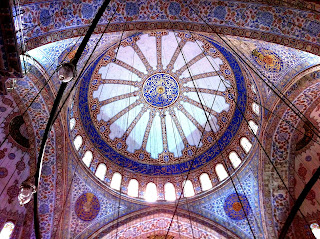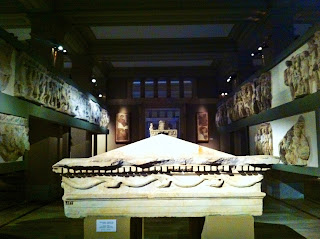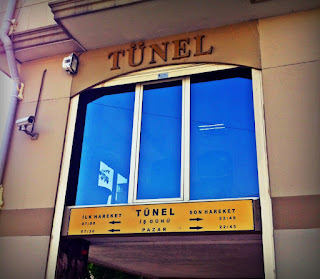We've been seeing a lot of history and ancient things on our travels, but we knew we were REALLY going to see some old and grand things when we got to Istanbul!
Our day started by visiting the Sultan Ahmet's mosque, or the Blue Mosque, as it is more commonly known. Visitors are allowed to enter the prayer hall except for 30 minutes past the scheduled prayer times (ezan) and for several hours on Friday during their Friday 'service'. The prayer times change daily according to longitude and latitude, sunrise and sunset, and geographic relationship to Mecca. For that reason, the website www.islamicfinder.com is very helpful in knowing when to avoid visiting any mosques around these 6 ezan times. Of course there are dress codes, but the Blue Mosque will loan a skirt and headscarf without the proper attire.
The huge multi-domed mosque built for Sultan Ahmet in the 1600s was definitely magnificent as promised. We wished we could enjoy gaping at the most beautiful and intricate blue tiled and stained glass ceilings and walls forever, but it was difficult to avoid the push and pull of all the people vying for the same view. We did a quick barefoot walk through on the soft red Turkish carpet, took a photo by the very small, cordoned off "women's section" of the prayer hall, and got out.
Right outside of the Blue Mosque is the Hippodrome, a sporting area for horse and chariot racing during the Byzantine times, starting with Constantine in 330AD. Several landmarks stood out.
 |
| View of Constantine's Hippodrome. |
 |
| Mike in front of Constantine's Obelisk at Constantine's Hippodrome, built in 10th century AD. |
 |
| Vendor selling simit (ring shaped dough with sesame seeds) at Hippodrome |
Behind the Blue Mosque is a sedate street lined with upscale shops selling traditional Turkish pottery, tiles, carpets, linen, and souvenirs called Arasta Bazaar. The bazaar was originally formed as a way to increase income for the mosque. Akiko fell in love with the Turkish towels. They are made of handwoven fabric with natural dyes, and not as fluffy as the American towels, which we tend to prefer. They are quite expensive, but we wished we could take some home with us!
Across the main open area from the Blue Mosque sits the Hagia Sophia, what used to be the largest Orthodox Church in the world during the Byzantine Empire, then converted into a mosque upon Ottoman's conquest, then turned into a museum when Turkey became a secular republic in 1923. We got a great panoramic photo of this hard-to-miss salmon colored structure, but decided to postpone an interior visit as the line was extremely loooong. (We saw at least 3 huge cruise ships moored on the Bosphorus Strait, plus all the other tourists like us).
We instead went underground to cool off in the Basilica Cistern (10 lira admission/pp). A cistern is basically an underground water reservoir. This one was built by the Byzantine Emperor Justinianus during the 6th century as a place to store clean water for the royalty living in and around Topkapi Palace. The water came from the Belgrad Forest, 19 km away via aqueducts. Out of the 330+ roman columns, 3 are special. One is by the "wishing pond" where people touch this column to make a wish. The other 2 columns are supported by the Medusa's head. No one knows where the Medusa's heads came from.
After a quick lunch of kebab wrapped in durum, a flatbread that looked and tasted strikingly like flour tortilla, we headed to the Istanbul Archeology Museum. By the way, we noticed a dramatic increase in food cost around the Sultanahmet historic area. We know lots of people also stay in hotels around this area, but we are glad we decided to stay across the Golden Horn in the Beyoglu neighborhood where we can find more down-to-earth costs for the same thing.
 |
| Lady making durum, a type of Turkish flatbread. |
We wanted to see some really, really old things at the Istanbul Archeology Museum (10 lira/pp; closed Mondays)! We started seeing an overabundance of archeological ruins strewn about the grounds long before we even reached the entrance. The museum was divided into 3 buildings: the Archeology Museum, Tiled Pavilion, and Museum of Ancient Orient.
 |
| Istanbul Archeology Museum |
The main attraction in the Archeology Museum is the Sarcophagi of the Royal Necropolis of Sidon (in present day Lebanon). In 1887, a farmer reported finding ornate tombs in his 'backyard' while trying to dig a well. This area was under Ottoman rule at the time, so that is how Turkey acquired the 18 sarcophagi or tombs of royalty from the 6th to 4th century BC. The most famous tomb is called Alexander's Sarcophagus, named after Alexander the Great because he is depicted in the carvings, but was a sarcophagus for the Persian king who fought Alexander.
 |
| Roman statue of Bes greets us at the entrance |
 |
| Mummified remains with internal organs still 'intact' |
 |
| Alexander's Sarcophagus |
There are other sarcophagi displays, including a Columned Sarcophagi of Anatolia, where portions of a huge columned building was recovered.
The Tiled Pavilion is located in the only original non-religious building in Istanbul, as part of the outer palace grounds for Sultan Mehmet in 1472. Per its namesake, there were plenty of beautiful tile and pottery from the Ottoman area displayed. So breathtaking. Colorful and ornate but not gaudy.
We were looking forward to witnessing some really, really ancient stuff in the Museum of the Ancient Orient. Here houses some artifacts all the way back from 2500 BC Mesapotamia, Egypt, Babylon, etc. How they can tell the age is beyond our comprehension.
Well, that summed up our 6-hour day in the historic Sultanahmet district. We started walking back to our apartment, but it's all uphill on the way back! We walked most of the way, but caved and took the funicular line (F2) from Karakoy to Tunel station for the really steep part.
Our ice cold watermelon that we bought from back of a truck awaited us when we returned. The watermelon was so good, we went back and bought a yellow melon from the same guy. Don't judge the melon by its cover! We'll let you know how good it was tomorrow.















































